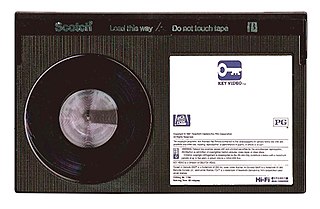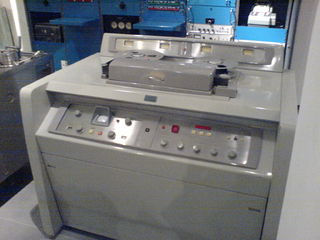Related Research Articles

Magnetic tape is a medium for magnetic storage made of a thin, magnetizable coating on a long, narrow strip of plastic film. It was developed in Germany in 1928, based on magnetic wire recording. Devices that record and playback audio and video using magnetic tape are tape recorders and video tape recorders respectively.

VHS is a standard for consumer-level analog video recording on tape cassettes.

DV refers to a family of codecs and tape formats used for storing digital video, launched in 1995 by a consortium of video camera manufacturers led by Sony and Panasonic. In the late 1990s and early 2000s, DV was strongly associated with the transition from analog to digital desktop video production, and also with several enduring "prosumer" camera designs such as the Sony VX-1000. DV is sometimes referred to as MiniDV, which was the most popular tape format using a DV codec during this time.

Videotape is magnetic tape used for storing video and usually sound in addition. Information stored can be in the form of either an analog or digital signal. Videotape is used in both video tape recorders (VTRs) and, more commonly, videocassette recorders (VCRs) and camcorders. Videotapes have also been used for storing scientific or medical data, such as the data produced by an electrocardiogram.

S-VHS (スーパー・ヴィエイチエス), the common initialism for Super VHS, is an improved version of the VHS standard for consumer-level video recording. Victor Company of Japan introduced S-VHS in Japan in April 1987, with their JVC-branded HR-S7000 VCR, and in certain overseas markets soon afterward. By the end of 1987, the first S-VHS VCR models from other competitors included Hitachi VT-2700A, Mitsubishi HS-423UR, Panasonic PV-S4764, RCA VPT-695HF, and Toshiba SV-950.

Betamax is a consumer-level analog recording and cassette format of magnetic tape for video, commonly known as a video cassette recorder. It was developed by Sony and was released in Japan on May 10, 1975, followed by the US in November of the same year.

Video 2000 is a consumer videocassette system and analogue recording standard developed by Philips and Grundig to compete with JVC's VHS and Sony's Betamax video technologies. It was designed for the PAL color television standard, but some models additionally handled SECAM. Distribution of Video 2000 products began in 1979 exclusively in Europe, South Africa and Argentina and ended in 1988.

A camcorder is a self-contained portable electronic device with video and recording as its primary function. It is typically equipped with an articulating screen mounted on the left side, a belt to facilitate holding on the right side, hot-swappable battery facing towards the user, hot-swappable recording media, and an internally contained quiet optical zoom lens.
Betacam is a family of half-inch professional videocassette products developed by Sony in 1982. In colloquial use, "Betacam" singly is often used to refer to a Betacam camcorder, a Betacam tape, a Betacam video recorder or the format itself.

A video tape recorder (VTR) is a tape recorder designed to record and play back video and audio material from magnetic tape. The early VTRs were open-reel devices that record on individual reels of 2-inch-wide (5.08 cm) tape. They were used in television studios, serving as a replacement for motion picture film stock and making recording for television applications cheaper and quicker. Beginning in 1963, videotape machines made instant replay during televised sporting events possible. Improved formats, in which the tape was contained inside a videocassette, were introduced around 1969; the machines which play them are called videocassette recorders.

The 8mm video format refers informally to three related videocassette formats. These are the original Video8 format and its improved successor Hi8, as well as a more recent digital recording format known as Digital8. Their user base consisted mainly of amateur camcorder users, although they also saw important use in the professional television production field.
VHS-C is the compact VHS videocassette format, introduced by Victor Company of Japan (JVC) in 1982, and used primarily for consumer-grade compact analog recording camcorders. The format is based on the same video tape as is used in VHS, and can be played back in a standard VHS VCR with an adapter. Though quite inexpensive, the format is largely obsolete even as a consumer standard and has been replaced in the marketplace by digital video formats, which have smaller form factors.

U-matic is an analogue recording videocassette format first shown by Sony in prototype in October 1969, and introduced to the market in September 1971. It was among the first video formats to contain the videotape inside a cassette, as opposed to the various reel-to-reel or open-reel formats of the time. The videotape is 3⁄4 in (19 mm) wide, so the format is often known as "three-quarter-inch" or simply "three-quarter", compared to open reel videotape formats in use, such as 1 in (25 mm) type C videotape and 2 in (51 mm) quadruplex videotape.

D-VHS is a digital video recording format developed by JVC, in collaboration with Hitachi, Matsushita, and Philips. The "D" in D-VHS originally stood for "Data", but JVC renamed the format as "Digital VHS". Released in 1998, it uses the same physical cassette format and recording mechanism as S-VHS, but requires higher-quality and more expensive tapes and is capable of recording and displaying both standard-definition and high-definition content. The content data format is in MPEG transport stream, the same data format used for most digital television applications.
MII is a professional analog recording videocassette format developed by Panasonic in 1986 in competition with Sony's Betacam SP format. It was technically similar to Betacam SP, using metal-formulated tape loaded in the cassette, and utilizing component video recording.
M is the name of a professional analog videocassette format created around 1982 by Matsushita and RCA. Developed as a competitor to Sony's Betacam format, M used the same videocassette as VHS, much the same way that Betacam was designed to take advantage of cheap and readily available Betamax videocassettes,
Digital audio cassette formats introduced to the professional audio and consumer markets:

D-9 or Digital-S as it was originally known, is a professional digital video videocassette format created by JVC in 1995.

Compact Video Cassette (CVC) was one of the first analog recording videocassette formats to use a tape smaller than its earlier predecessors of VHS and Betamax, and was developed by Funai Electronics of Japan for portable use. The first model of VCR for the format was the Model 212, introduced in 1980 by both Funai and Technicolor as they had created a joint venture to manufacture and introduce the format to the home movie market. The system, which included the VCR and a hand held video camera, was very small and lightweight for its time.

A videocassette recorder (VCR) or video recorder is an electromechanical device that records analog audio and analog video from broadcast television or other source on a removable, magnetic tape videocassette, and can play back the recording. Use of a VCR to record a television program to play back at a more convenient time is commonly referred to as timeshifting. VCRs can also play back prerecorded tapes. In the 1980s and 1990s, prerecorded videotapes were widely available for purchase and rental, and blank tapes were sold to make recordings.
References
References
- ↑ "cassette-tape". Your Dictionary. Retrieved April 20, 2020.
A cassette, used to record and play audio. (emphasis added)
- ↑ "Meaning of cassette tape in English". Oxford Dictionary. Archived from the original on November 9, 2021. Retrieved April 20, 2020.
A cassette of audio tape or videotape (emphasis added)
- ↑ "Cassette ... Also called cassette tape". Dictionary.com. Retrieved April 20, 2020.
a compact case ... : used for recording or playback of audio or video ..., and for storage of data by some small computer systems. ... (emphasis added)
- 1 2 "Magnetic Tape for Audio". The Museum of Obsolete Media. Retrieved April 8, 2020.
- 1 2 "Video Tape". The Museum of Obsolete Media. Retrieved April 8, 2020.
- 1 2 "Magnetic Tape for Data". The Museum of Obsolete Media. Retrieved April 8, 2020.